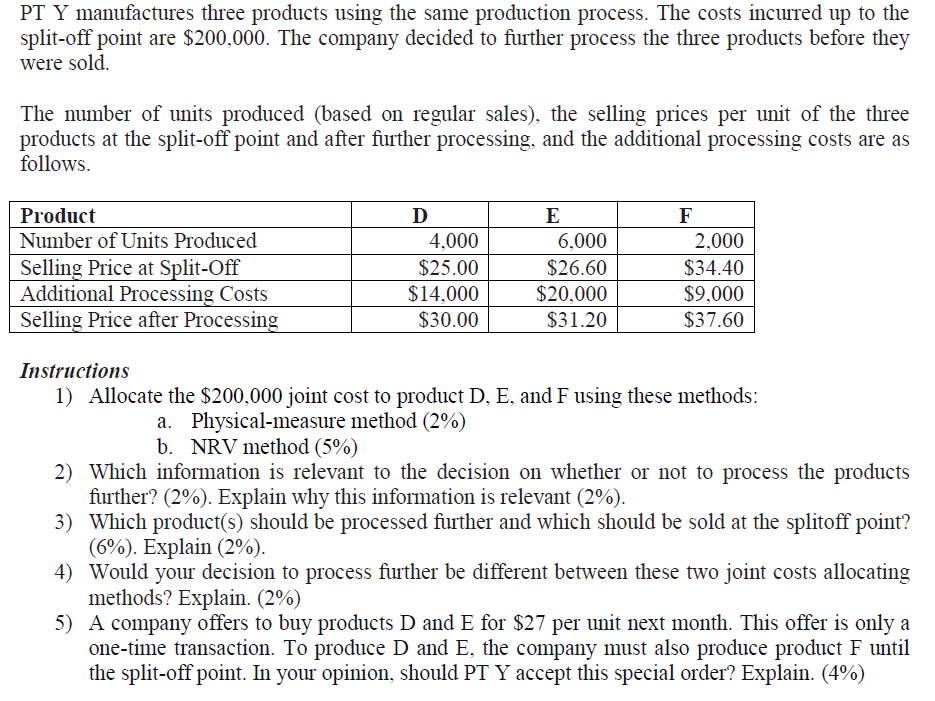PT Y manufactures three products using the same production process. The costs incurred up to the split-off point are $200,000. The company decided to further process the three products before they were sold. The number of units produced (based on regular sales), the selling prices per unit of the three products at the split-off point and after further processing, and the additional processing costs are as follows. Product D E F Number of Units Produced 4,000 6,000 2,000 Selling Price at Split-Off Additional Processing Costs Selling Price after Processing $25.00 $26.60 $34.40 $14,000 $20,000 $9,000 $30.00 $31.20 $37.60 Instructions 1) Allocate the $200,000 joint cost to product D, E, and F using these methods: a. Physical-measure method (2%) b. NRV method (5%) 2) Which information is relevant to the decision on whether or not to process the products further? (2%). Explain why this information is relevant (2%). 3) Which product(s) should be processed further and which should be sold at the splitoff point? (6%). Explain (2%). 4) Would your decision to process further be different between these two joint costs allocating methods? Explain. (2%) 5) A company offers to buy products D and E for $27 per unit next month. This offer is only a one-time transaction. To produce D and E, the company must also produce product F until the split-off point. In your opinion, should PT Y accept this special order? Explain. (4%)
PT Y manufactures three products using the same production process. The costs incurred up to the split-off point are $200,000. The company decided to further process the three products before they were sold. The number of units produced (based on regular sales), the selling prices per unit of the three products at the split-off point and after further processing, and the additional processing costs are as follows. Product D E F Number of Units Produced 4,000 6,000 2,000 Selling Price at Split-Off Additional Processing Costs Selling Price after Processing $25.00 $26.60 $34.40 $14,000 $20,000 $9,000 $30.00 $31.20 $37.60 Instructions 1) Allocate the $200,000 joint cost to product D, E, and F using these methods: a. Physical-measure method (2%) b. NRV method (5%) 2) Which information is relevant to the decision on whether or not to process the products further? (2%). Explain why this information is relevant (2%). 3) Which product(s) should be processed further and which should be sold at the splitoff point? (6%). Explain (2%). 4) Would your decision to process further be different between these two joint costs allocating methods? Explain. (2%) 5) A company offers to buy products D and E for $27 per unit next month. This offer is only a one-time transaction. To produce D and E, the company must also produce product F until the split-off point. In your opinion, should PT Y accept this special order? Explain. (4%)
Cornerstones of Cost Management (Cornerstones Series)
4th Edition
ISBN:9781305970663
Author:Don R. Hansen, Maryanne M. Mowen
Publisher:Don R. Hansen, Maryanne M. Mowen
Chapter7: Allocating Costs Of Support Departments And Joint Products
Section: Chapter Questions
Problem 27E: Pacheco, Inc., produces two products, overs and unders, in a single process. The joint costs of this...
Related questions
Question

Transcribed Image Text:PT Y manufactures three products using the same production process. The costs incurred up to the
split-off point are $200,000. The company decided to further process the three products before they
were sold.
The number of units produced (based on regular sales), the selling prices per unit of the three
products at the split-off point and after further processing, and the additional processing costs are as
follows.
Product
D
E
F
Number of Units Produced
4,000
6,000
2,000
Selling Price at Split-Off
Additional Processing Costs
Selling Price after Processing
$25.00
$26.60
$34.40
$14,000
$20,000
$9,000
$30.00
$31.20
$37.60
Instructions
1) Allocate the $200,000 joint cost to product D, E, and F using these methods:
a. Physical-measure method (2%)
b. NRV method (5%)
2) Which information is relevant to the decision on whether or not to process the products
further? (2%). Explain why this information is relevant (2%).
3) Which product(s) should be processed further and which should be sold at the splitoff point?
(6%). Explain (2%).
4) Would your decision to process further be different between these two joint costs allocating
methods? Explain. (2%)
5) A company offers to buy products D and E for $27 per unit next month. This offer is only a
one-time transaction. To produce D and E, the company must also produce product F until
the split-off point. In your opinion, should PT Y accept this special order? Explain. (4%)
Expert Solution
This question has been solved!
Explore an expertly crafted, step-by-step solution for a thorough understanding of key concepts.
This is a popular solution!
Trending now
This is a popular solution!
Step by step
Solved in 3 steps with 1 images

Recommended textbooks for you

Cornerstones of Cost Management (Cornerstones Ser…
Accounting
ISBN:
9781305970663
Author:
Don R. Hansen, Maryanne M. Mowen
Publisher:
Cengage Learning

Principles of Cost Accounting
Accounting
ISBN:
9781305087408
Author:
Edward J. Vanderbeck, Maria R. Mitchell
Publisher:
Cengage Learning

Financial And Managerial Accounting
Accounting
ISBN:
9781337902663
Author:
WARREN, Carl S.
Publisher:
Cengage Learning,

Cornerstones of Cost Management (Cornerstones Ser…
Accounting
ISBN:
9781305970663
Author:
Don R. Hansen, Maryanne M. Mowen
Publisher:
Cengage Learning

Principles of Cost Accounting
Accounting
ISBN:
9781305087408
Author:
Edward J. Vanderbeck, Maria R. Mitchell
Publisher:
Cengage Learning

Financial And Managerial Accounting
Accounting
ISBN:
9781337902663
Author:
WARREN, Carl S.
Publisher:
Cengage Learning,

Managerial Accounting
Accounting
ISBN:
9781337912020
Author:
Carl Warren, Ph.d. Cma William B. Tayler
Publisher:
South-Western College Pub

Principles of Accounting Volume 2
Accounting
ISBN:
9781947172609
Author:
OpenStax
Publisher:
OpenStax College